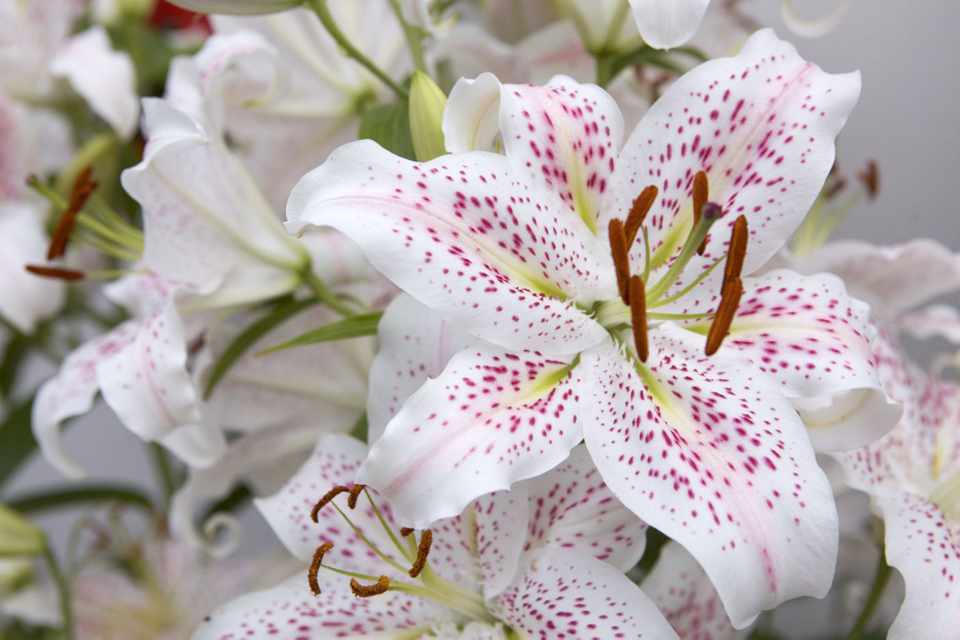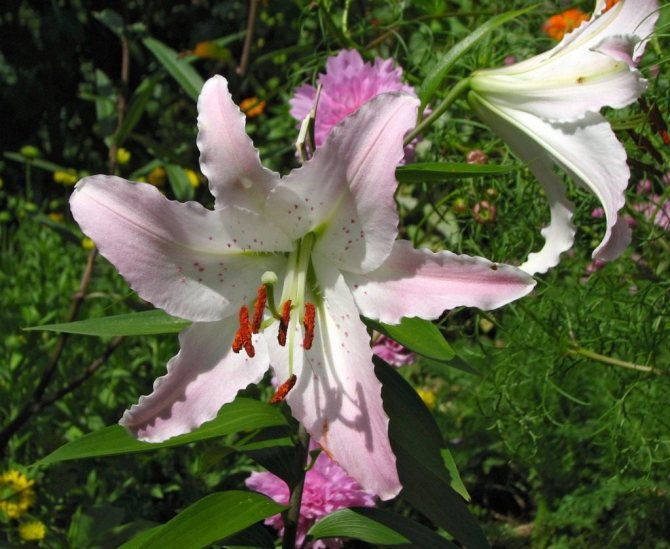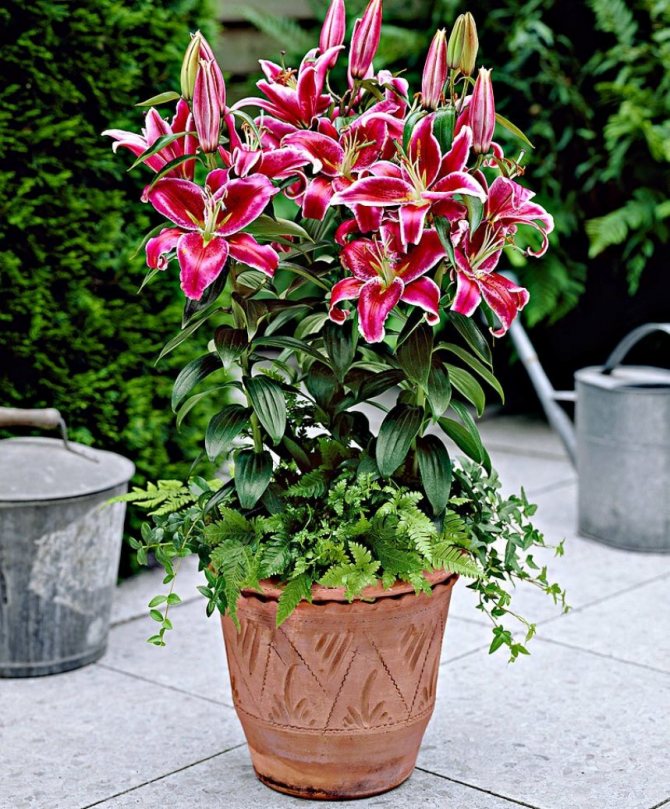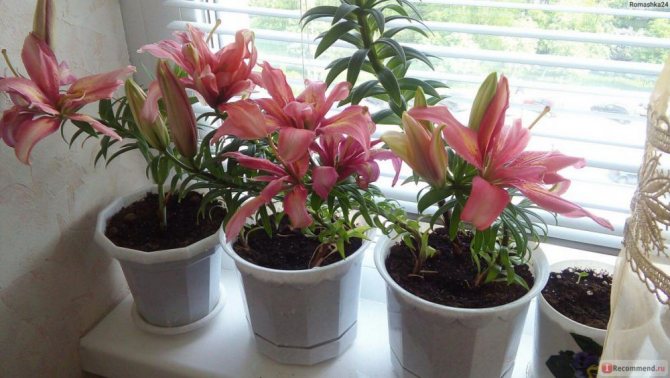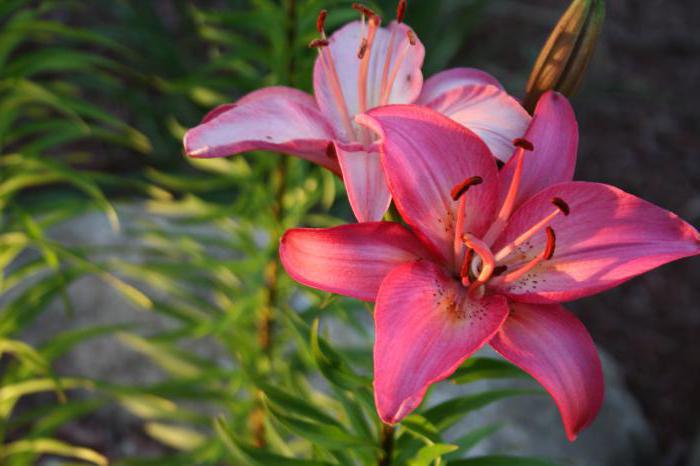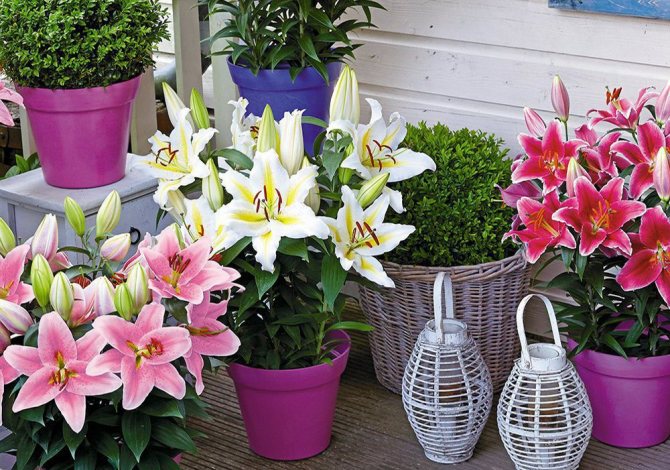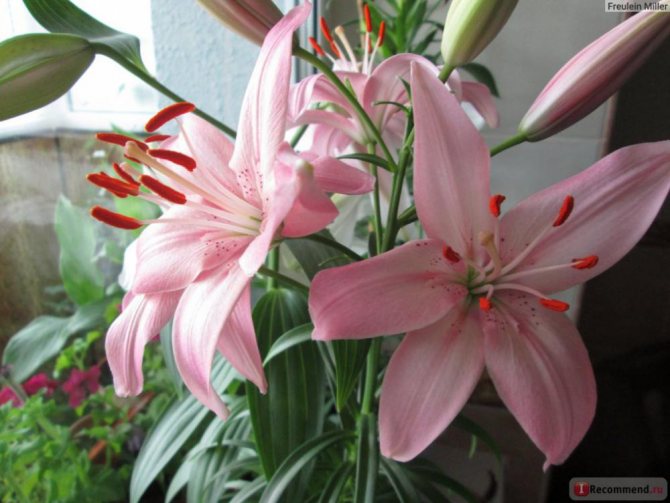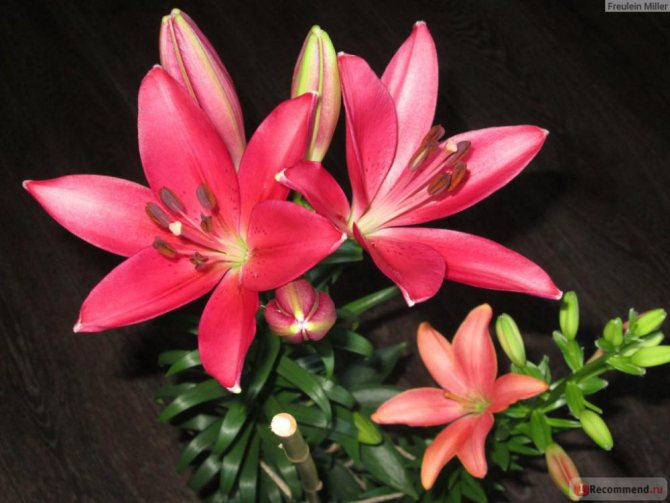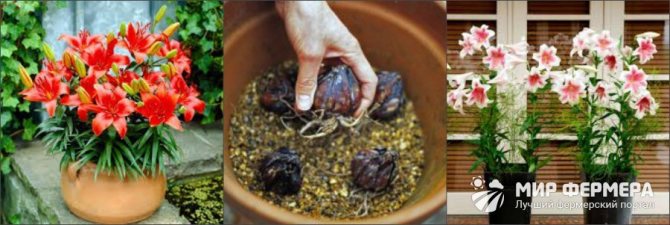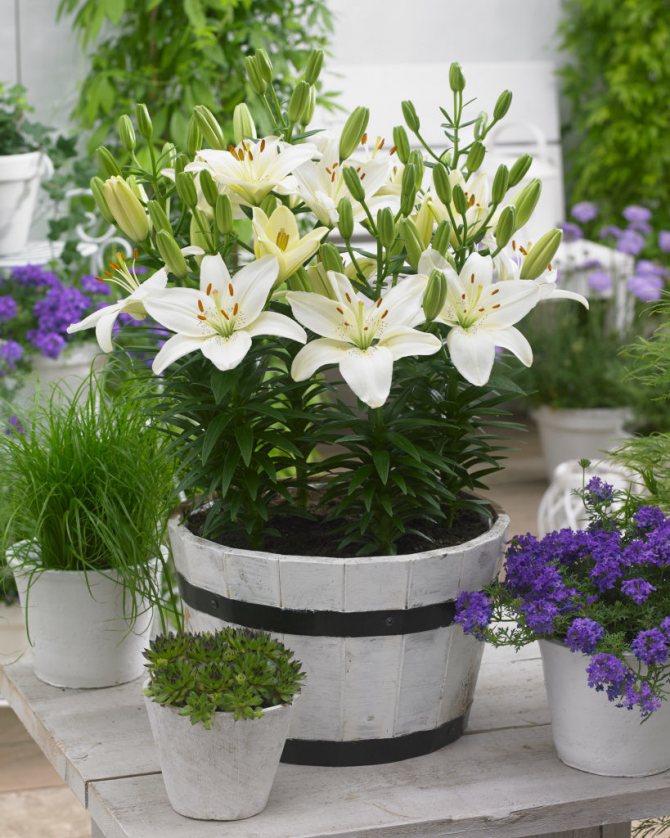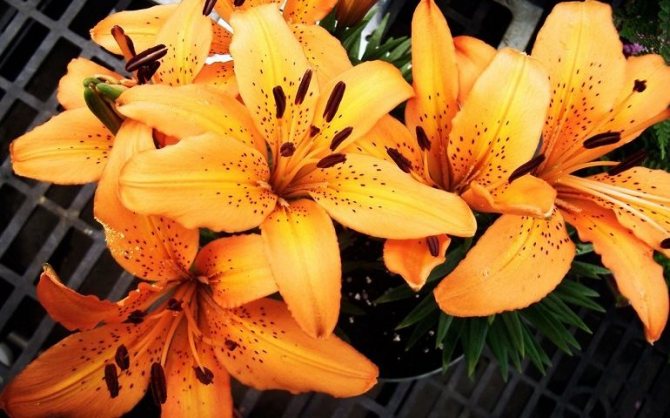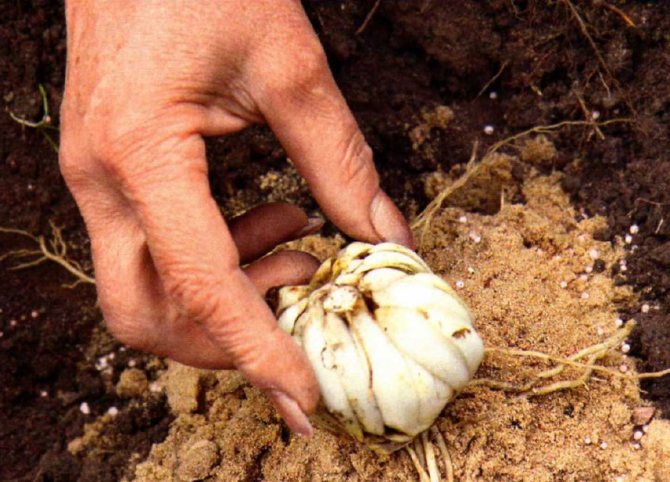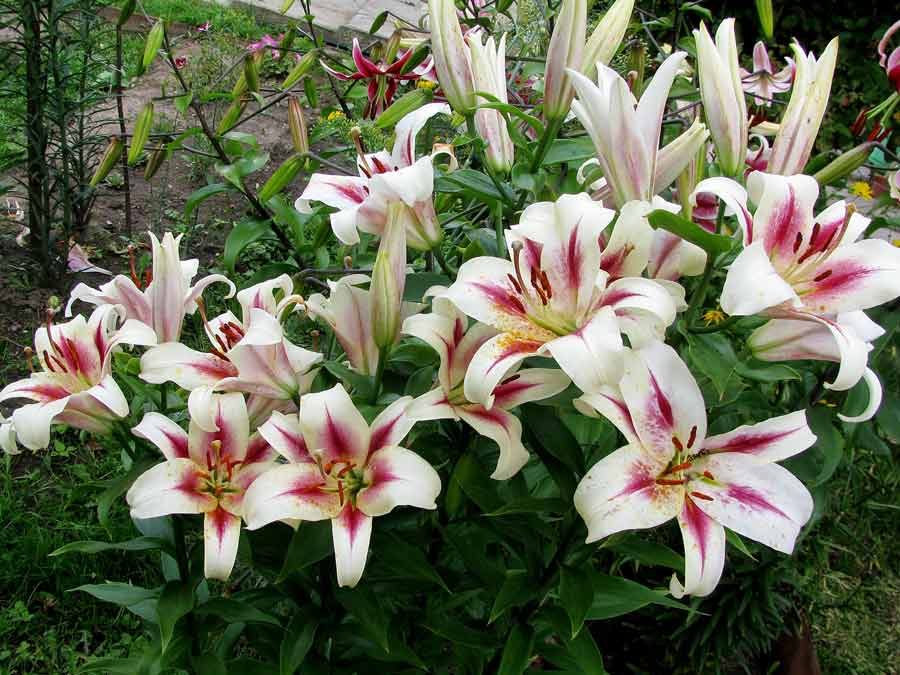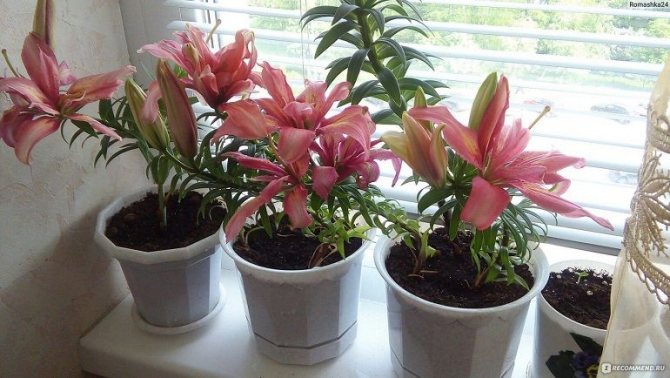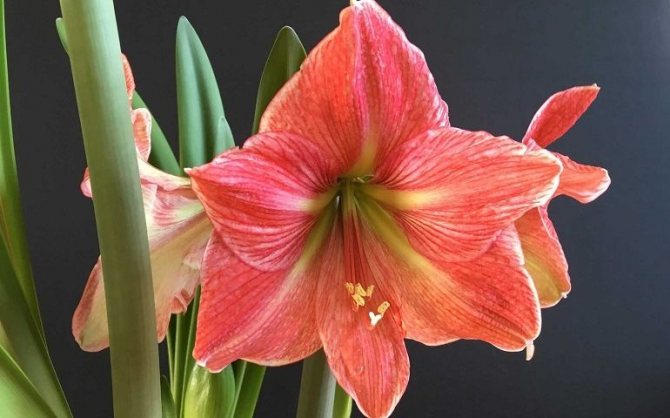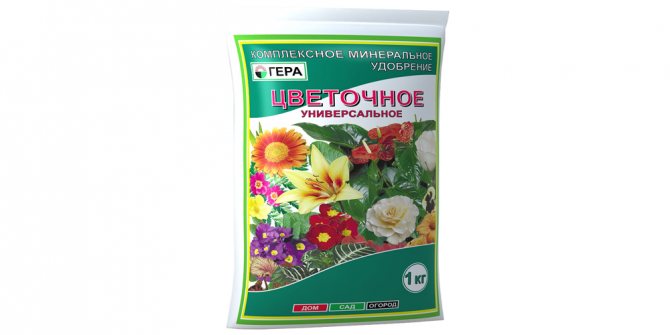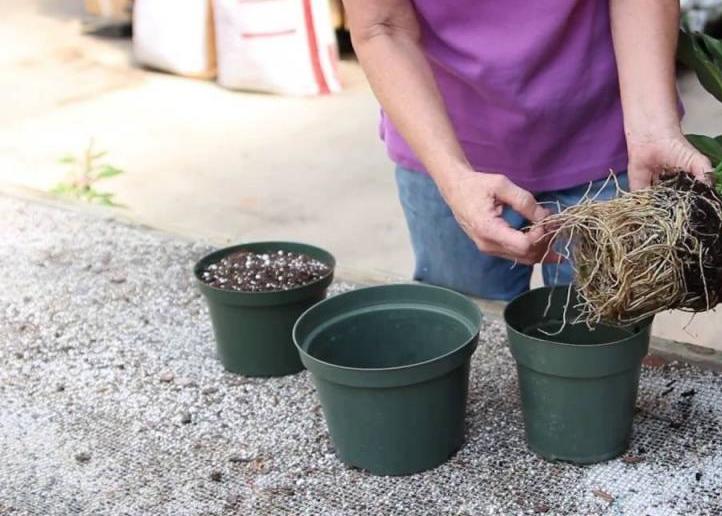Among the most popular and beloved indoor plants, the lily takes pride of place, home care for which is quite simple. For growing in apartments and houses, flower growers choose not tall garden crops, but shorter and more compact hybrids. They post photos and names of their beautiful indoor lilies on numerous forums on the Internet. Ornamental plants charm with their large bright inflorescences and luscious greenery.
What should be a pot for a home lily
For growing lilies at home, you can use almost any type of container: an ordinary flower pot, a spacious ceramic flowerpot, a plastic box. The size of the container depends on the number of bulbs you plan to plant and the type of lily.
The pot must be large enough and deep enough for the plant to develop properly. The higher the flower, the wider and deeper the container should be. You also need to take into account that too light containers are not suitable for a lily. Otherwise, the container may fall under the weight of the tall stem and flower. If the container is made of thin plastic, a weighty drain (for example, pebbles) should be placed on the bottom to make it heavier.
With a stem height of 1.5 m, the height of the pot wall should be at least 35-40 cm. The volume of the planting space for one bulb is 16 sq. Cm. Thus, 3-4 bulbs can be planted in a pot with a diameter of about 40 cm. Planting in separate pots is rarely practiced because lily bulbs actively grow babies until all the necessary space of the earth is filled, and until that moment they bloom.
Why does the lily not bloom
With proper home care, a decorative lily will certainly produce large buds, as seen in many photos. They bloom and thin out a pleasant delicate scent. If you constantly make mistakes in the content of the culture, it will stop forming flower buds. In such situations, the plant simply does not have enough strength and useful compounds to move on to flowering.
Lily does not release sprouts with buds due to lack of moisture in the soil or insufficient air humidity. Decorative indoor lily flowers often wither, the names and photos of such fastidious plants are known to many flower growers. They suffer from a lack of light and fresh air. Often they stop actively growing and hibernate if they are in a poorly ventilated room. Hybrid bulbs planted in a wide flowerpot begin to grow babies. They lack energy for the flowering period, especially if they have not rested in winter for at least 2 months.
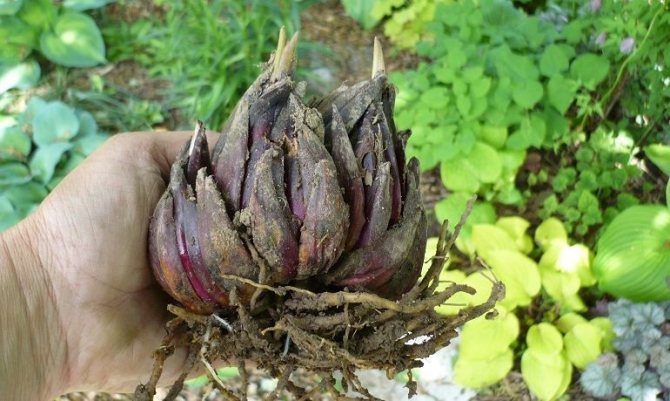
Preparing lilies for planting
For growing lilies, a mixture of turf soil with humus or compost in a 1: 1 ratio is ideal. To make things easier for yourself, you can buy a ready-made primer for these flowers. But keep in mind: before planting, any soil must be spilled with a solution of potassium permanganate or boiling water for disinfection.
The bulbs must also be prepared in advance. They are first dipped in a pink solution of potassium permanganate for 1-2 hours, and then soaked in any growth stimulator (for example, Epine) for 10-12 hours. But if you are in no hurry to get a flowering plant, you can do without the last procedure.
The bulbs can be planted at any time, but it is better to do this at the same time as when planting in open ground (in April) or a little earlier (in early March). Then in late spring - early summer you can already admire the flowering of charming lilies.
Tips for a beginner
In order for the lily to grow healthy, you need to cut off all the buds that have set in the first year. This will allow the plant to save energy for further development. Otherwise, the lily may die. If the plant looks weakened, drooping, the buds are cut at any age.
If in the summer the lily will be taken out into the air, you need to put it under a canopy. Precipitation should not fall on it. By following simple rules, you can achieve significant results. The plant will delight you with abundant, spectacular flowering. A healthy lily will be disease and pest resistant. Delicate, bright or dazzling white buds bloom on the shoots, emitting a pleasant aroma. They will decorate the interior, creating coziness and comfort in the house.
How to plant a lily in a pot
Drainage (sea or river pebbles, broken brick, expanded clay) is poured onto the bottom of the container with a layer of 5 cm, and on top of it is a previously prepared fertile soil with a layer of 10 cm. On the surface of the earth, the bulbs are laid out with the bottom down, straightening the roots. Fertile soil is poured on top with a layer of about 20 cm. After that, the soil is slowly watered with warm water so that it is evenly saturated with moisture.
When planting lily bulbs in a pot, keep in mind that the earth is not poured to the top. About 7 cm should remain to the edge of the container, since as the stem grows, it will be necessary to add soil to the pot, which will cover the overgrown roots.
Planting bulbs
To plant a lily in a pot, use the bulbs or seeds of the plant. The first option is the only one possible for white varieties of flowers. Not all varieties of lilies are capable of growing from seeds.
Planting the bulb in a pot must be done in the first days of spring. In this case, the lilies at home will bloom throughout the summer. Only healthy bulbs are suitable for planting in the ground. They should not have any defects, rot.
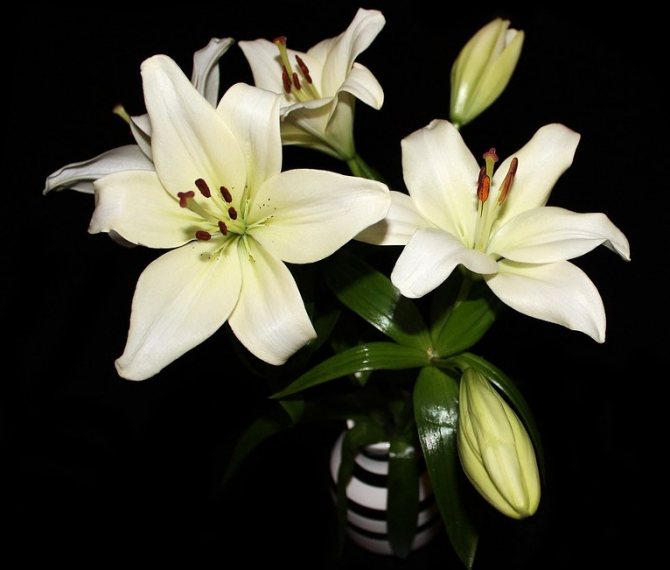

You can plant several bulbs of the same or different varieties in one pot. In the second case, the composition will be original. Care rules in this case will be the same as for one variety of flowers.
How to care for potted lilies
Caring for a lily in a pot is simple, but without some procedures it is impossible to achieve abundant flowering. After planting the bulbs, the soil in the pot is watered as the earthen coma dries up (usually every 3 days). It is advisable to keep the plants in a cool place (at a temperature of 10-15 ° C) until sprouts appear.
After germination, lilies can be fed with organic matter, but this is not necessary if you used fertile soil when planting. If the lily receives enough light, but still grows very slowly, it should be sprayed with a growth stimulant solution. This procedure is recommended to be carried out 1-2 times a week. It stimulates not only the growth of shoots, but also the laying of flower buds.
When the stems reach a height of 10 cm, soil is poured into the pot. After that, caring for the plants is reduced to timely watering and loosening the soil to a depth of about 5 cm, so that air can flow to the roots.
Once a week, it is useful to feed the lily with a liquid complex fertilizer for flowering plants (according to the instructions for a specific preparation).
At the age of 1 month, in good weather, the lily can be taken out into the garden or on the balcony, but the plant must be accustomed to this gradually. On the first day, the flower should "breathe" fresh air for no more than 30 minutes, and when the plant gets used to it, it can be left outside for up to 10 hours.In the warm season, lilies are taken home only at night, because the air temperature below 10 ° C inhibits the process of laying flower buds.
Until the buds form, it is useful to spray the lily leaves daily with water at room temperature. But at this time the sun's rays should not fall on the plants. Otherwise, burns may occur. You can continue spraying after the flowers have bloomed, but it is important to ensure that no water drops fall on the petals. In addition, during flowering, tall lilies may need supports to help the stems hold the heavy flowers.
Pests and diseases
Cessation of growth, lethargy, falling and yellowing leaves are all obvious symptoms of pathology. This is evidence that the beautiful houseplant lily began to hurt or was attacked by parasites or dangerous insects, enlarged photos of which horrify everyone without exception.
In excessively humid and warm air, fungal spores begin to multiply on the stems and leaves of the lily. Without proper treatment, the flower will certainly die. It must be treated with a special antifungal drug. Rhizomes are gradually destroyed from the inside, and the foliage turns yellow and falls off in plants with fusarium disease. To prevent such a disease, the roots are soaked in an aqueous solution of foundationol for half an hour.
Due to the stagnation of water in the ground, the flower is affected by gray or red rot. With a lack of mineral fertilizers, the lily foliage becomes thinner, becomes rare and completely falls off. To restore the beauty of the plant, it is periodically fed. Pests, for example, scale insects, mealybugs, spider mites, are fought with the help of liquid insecticides. They water the soil and cultivate the ground part of the flower.
What to do when the lily in the pot has faded
After the buds dry out and fall off, watering is reduced to 1 time per week, and the leaves are no longer sprayed. At this time, it is important that all the nutrients accumulated in the leaves and stems are transferred to the bulbs, therefore, in no case should the aerial part of the lily be cut off immediately after the end of flowering. It is necessary to wait until the leaves and stems turn yellow and dry on their own.
After the dying off of the aerial part, the bulbs stop watering, and after 2 weeks they are dug up and placed in storage. It makes no sense to leave lilies in this pot, since the soil in it is already depleted. In the next season, she will not be able to provide the bulbs with the necessary nutrients.
It is better to plant the children in a separate container for growing, and the adult bulbs are washed under warm water, the stem is cut at a height of up to 5 cm, placed in a container with a solution of potassium permanganate and kept there for 30 minutes. Then it is dried in the fresh air for 2-2.5 hours. Then a slightly moistened moss, peat or sawdust is placed in a plastic bag and bulbs (1-2 pieces) are placed there.
The bag is stored in a refrigerator or basement at a temperature of about 5 ° C until next spring.
Some growers leave the bulbs in pots, but this storage method is less preferable: the planting material can get sick, dry out or rot, but you will not see it. In addition, in the spring, it is still better to transplant the bulbs into fresh soil, although less picky lilies can germinate in the next season and even bloom in the same soil. But risk-averse growers usually store lily bulbs in a cool place in a bag with a damp substrate.
Breeding methods for indoor lilies
Very often, a decorative flower is propagated by children, that is, by young bulbs growing near the largest mother. They are separated and deepened by 2-2.5 cm into the soil. The box with young seedlings is covered with polyethylene, periodic airing and watering are carried out.
Lily propagation by seeds is a rather long and laborious process.The seeds are bought in a store or obtained from a box that remains in the place of a wilted flower. It is advisable to start sowing in March. The seeds are buried in the soil by 1-1.5 cm.
The first green sprouts hatch, as a rule, after 3-5 weeks. They are grown in seedling boxes or small peat glasses in a warm and dark place.
After planting, a layer of river sand is poured over the soil. Containers with seeds are covered with foil or glass. When the first green leaves appear, the seedlings are moved to a well-lit place, for example, on a windowsill above a radiator. Fragile and delicate bulbs, when several leaves have already hatched on them, are carefully dived, and then transplanted into individual small pots. Lilies grown from seeds begin to bloom only in the 2nd year.
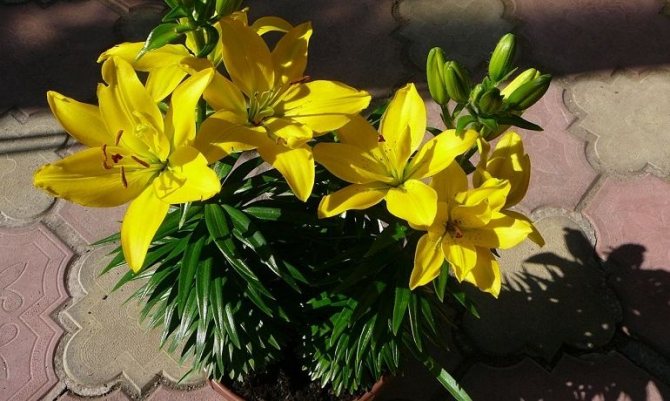

How does a lily in a pot feel?
At first glance, for lilies, pots and containers will be small for permanent residence. However, as practice shows, a short lily in a pot will feel great. It is important to choose a suitable variety that does not require large containers for adequate nutrition. Oriental and Asian varieties are suitable for growing in containers and pots.
A correctly selected varietal lily in a pot will become a real decoration of a house or apartment. After all, even grown in this way it will retain its individuality. A bright, exquisite flower will immediately draw attention to itself and decorate the interior. Moreover, you can start growing this plant at home in the middle of winter: the end of February and the beginning of March are suitable for planting a bulbous flower in pots.
Today there is a huge selection of lilies on sale. You can read about the features of these royal flowers and their types in the next article on our website.
Types of lilies
A house lily in a pot can produce a bud of different sizes, shapes and colors. In total, this species has about 300 varieties. Many of them can withstand a fairly serious drop in temperature, while others prefer to grow in a warm room.


Some types of house flowers are very similar to garden plants. This is especially true for varieties such as amaryllis and hippeastrum. Their bloom fascinates with its beauty. Such lilies become an ornament not only for window sills, but also for loggias, balconies, winter gardens, galleries.
Flowering lasts long enough that the owners of the plant cannot but rejoice. The buds can be very large. They can be painted in red, orange, white, golden shades. The violet colors of the lilies are also interesting. The choice of such plants is huge. The buds can be in the form of a gramophone, have a fringe. Shades can replace each other on the same plant. The petals can have a white edging, smoothly change shade from red to yellow, etc.
Lily has significant decorative qualities. When choosing a variety for cultivation, you need to study its preferences for growing conditions. Some varieties are suitable for a cold loggia, and others for a window in a warm room.
One of the most popular varieties of home potted lilies is Apollo. It is a white lily, whose flowers reach 12 cm in diameter. They grow in lush clusters, resembling dazzling white bells. They symbolize purity. This variety of flowers also has medicinal qualities. White lily tinctures are used as an analgesic, wound healing agent, as well as in the treatment of hematomas.
What you should know when deciding to grow a lily in a pot
As already mentioned, first of all, you should choose a low-growing plant variety. This will allow him to comfortably "live" in a capacity limited in volume. After all, the higher the plant, the more voluminous its root system. And more land is required for good nutrition.
Also, a lily in a pot or container will feel good if the following conditions are met:
- the container chosen for the lily must be strong and stable. An adult plant, even undersized varieties, has a long stem. And so that the pot does not turn over and is stable, a dense drainage should be placed on its bottom to make it heavier. It can be pebbles, broken brick;
- the soil should be acquired special for lilies. You can prepare it from a mixture of sand, peat, humus and nutrient soil;
- before putting in a pot, it is recommended to spill the soil with a weak solution of potassium permanganate. This will disinfect the earth, prevent plant diseases;
- for growing at home, you should choose only healthy planting material. The absence of rot on the bulbs, its strength and healthy appearance are the key to successful plant growth.
These rules will help flower growers prepare for an interesting and unusual activity: growing lilies in containers or pots. And in the earliest spring, please yourself with this amazing flower!
Landing in the ground
Lilies grow well in light soils. Pure river sand can be added to the soil. A drainage layer must be poured at the bottom. A prepared nutrient substrate is poured onto it. Several bulbs are placed in the container, spreading the roots. They are sprinkled with soil only half. The pot also does not have to be full. It is filled with soil to the middle of the container. As the shoots grow, the earth will need to be poured.
Next, the pot must be taken out to a cool, dark place. When the sprouts begin to appear from the ground, you need to take the container out to the windowsill. It should be light and warm enough here. This plant loves fresh air, so it will be advisable to grow it on a loggia or balcony. However, drafts should not be allowed.
Planting and care rules
Having prepared a container for planting lilies, the soil, choosing a place for the plant (it should be moderately lit, but not too long in direct sunlight), you can start planting.


Competent care will allow you to get a lush blooming bright flower at home.
We plant a lily in a pot correctly
In order for a lily in a pot to feel comfortable, to give quick shoots and large flowers, you will need to properly plant it.
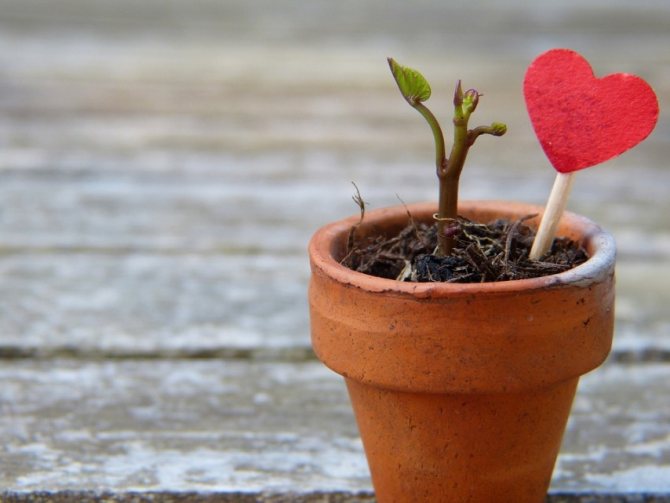

To awaken the "dormant" bulb, it is necessary to place it in a solution of a growth stimulant (for example, epin) before planting. 2-3 hours is enough. After that, you can plant it in a pot.
The depth of planting the bulbs is 10-15 cm. It should be remembered that the soil should not be placed in the container up to its very edges. As the plant grows, you will need to report the ground.
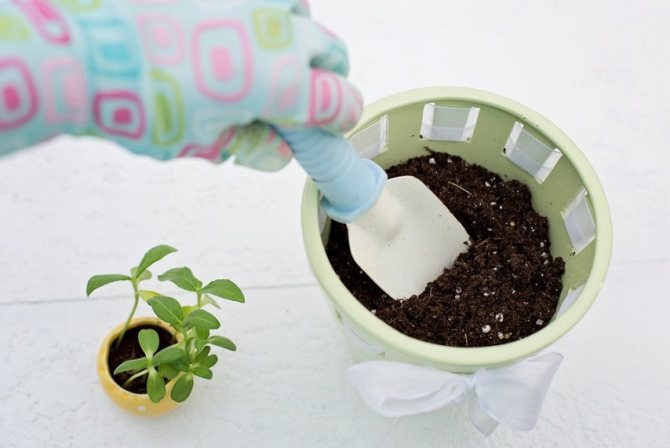

After planting the soil in the pot, it is gently spilled with warm water for 2-3 days.
Caring for a planted lily
The lack of difficulties in caring for a lily planted in a pot attracts many flower growers. However, there are a number of requirements that must be met to ensure a comfortable environment for a young plant.
During the sprouting period, it is necessary to keep the pot at a cool temperature. Watering is carried out as the earthen coma dries up: about three times a week.
After the sprout appears, it is necessary to feed the plant. For this, it is better to use organic fertilizers. If fertile special soil was used for planting, then the first feeding can be abandoned.
To speed up the growth of the plant, it is sprayed with a growth stimulant. This procedure stimulates the formation of flower buds. It is recommended to perform it once a week. A sufficient amount of light and fertile soil guarantee the rapid emergence of sprouts and subsequently flowers.
When the stem reaches a height of 10 cm, you will need to pour soil into the pot.
The appearance of the first buds
When buds appear, the plant is ready for the hardening procedure. This will allow you to subsequently take the pot out into the garden and on the veranda.
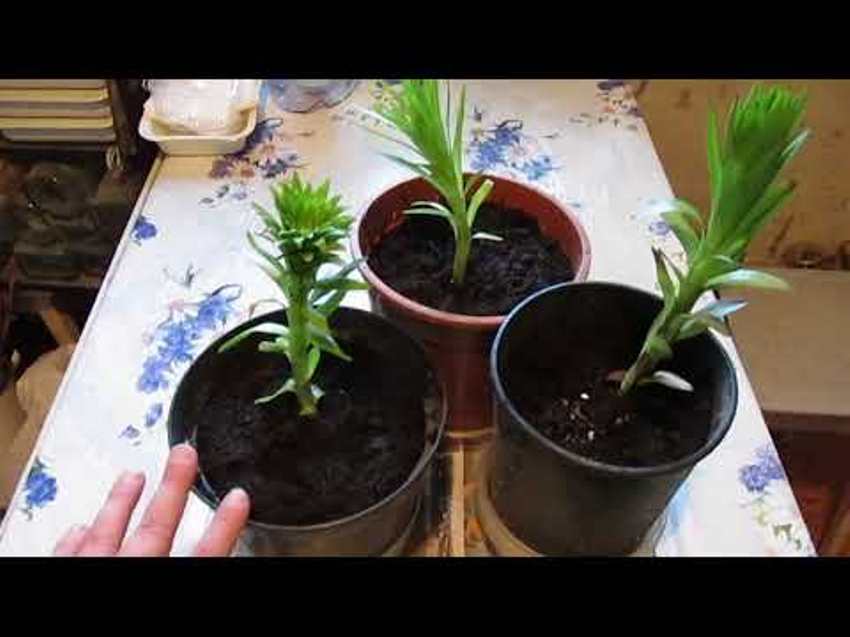

At first, it will be enough to place the flower in sunny warm weather with open windows.Then, as you get used to it, take it out to the sunlit veranda or balcony. And when warm nights come, leave the lily outside all day.
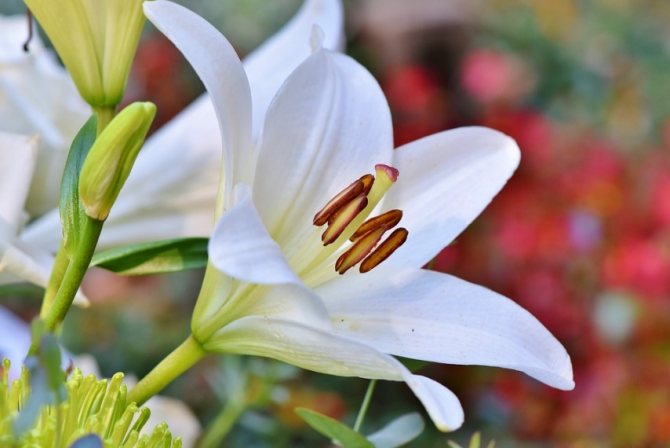

Spraying the plant with water should be carried out in dry times. However, you need to make sure that the water does not fall on the flower petals.
When the lily grows very tall, props can be used. They will relieve stress on the stem. And also prevent the risk of the pot overturning.
Hippeastrum and amaryllis
The lily in the pot can be of different types. Externally, the varieties hippeastrum and amaryllis are very similar. However, the peculiarities of their growth are different. These varieties have many differences. Outwardly, it may not immediately be possible to distinguish one plant from another. But according to some signs, you can determine the variety.
Amaryllis is dormant in winter. It blooms in autumn and summer. Hippeastrum behaves differently. This plant blooms in spring and winter. But the dormant period for this type of lily is summer.
Distinguishing one plant from another is important. Each of them needs special care. Amaryllis needs mineral fertilizers. Top dressing should be applied to the soil in this case twice a week. Hippeastrum needs not only mineral fertilizers. The plant must also be fed with organic matter.
By following these simple rules, you can grow a wonderful plant that will be healthy, not susceptible to diseases and pests.
During the flowering period, both of these species cannot be transplanted. During this period, they need high-quality watering. When flowering stops, watering is reduced. Both species need sufficient heat and light. However, direct sunlight can harm them. You also need to protect amaryllis and hypeastrium from drafts. Overheating is also unacceptable for them.
Getting ready to grow lily flowers in pots at home: photos of plants and the subtleties of preparation
Look closely at the various photos of lilies in pots, the amazing beauty of these flowering plants bewitches and enchants. If the decision to plant them is made, then we are preparing to grow lily flowers in pots. The subtleties of preparing for growing lilies at home in a pot include several secrets:
- the correct choice of planting material - the bulbs must be strong and weigh at least 40 grams;
- decide on the varieties - preference is given to oriental, dwarf, Asian, royal and long-flowered species;
- stratify the bulbs in the refrigerator for 15 - 20 days - the temperature should be about 5 degrees Celsius;
- before planting, first soak the bulbs for 2 hours in a solution of potassium permanganate;
- then for 12 hours in a solution of nutrient fertilizers and growth stimulant.
A lily flower in a pot can be grown without replanting the bulbs for 2 to 3 years. For this, it is necessary to provide optimal conditions for the wintering of the plant. In no case should containers with planting material be taken out onto the balcony in winter. Unprepared bulbs can freeze. How to store after flowering and what to do to get abundant budding for the next season, we will tell below. In the meantime, we offer a few more colorful photos of lilies in pots on the balcony and windowsill:
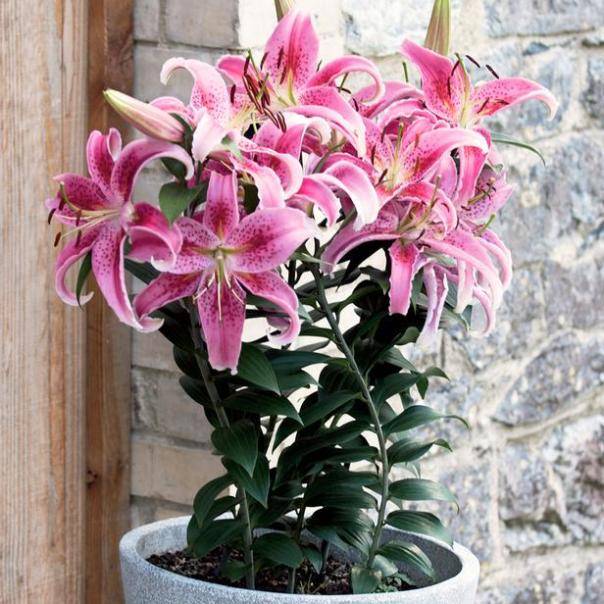

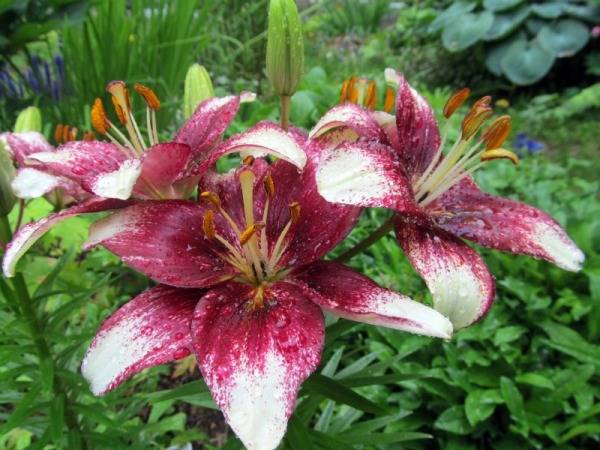

Dangers while growing lilies
Lily in a pot, like any other plant, is susceptible to some diseases and pest attacks. The most dangerous are fungal ailments. With proper care, the plant has good protection against such troubles. However, if the irrigation regime, lighting and other requirements are violated, the protective forces of the plant decrease.
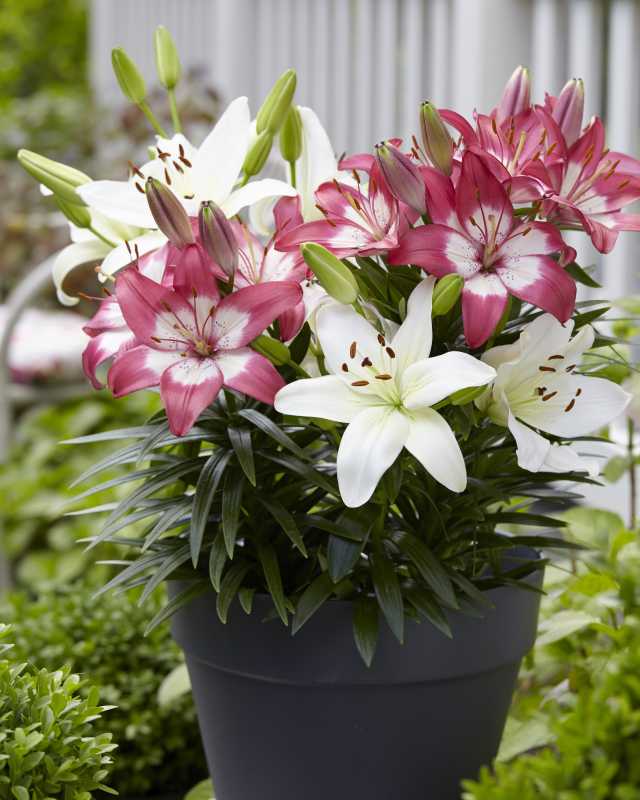

It is necessary to increase the air permeability of the earth. Periodically loosen it. If the plant does get sick, you need to purchase the appropriate type of fungicide. It is necessary to apply the composition strictly according to the manufacturer's instructions.
If the land has not been cleaned well enough, various pests may remain in it, for example, thrips, other insects. Effective insecticides are used against them.
How to plant a lily in a pot?
In order for something to start growing and developing, it is necessary to provide conditions for root growth and nutrition. Planting a lily in a pot involves choosing a suitable soil. It can be sod land mixed in equal proportions with humus or compost. When self-forming a soil mixture, do not forget about adding complex mineral fertilizers. As a rule, 50 grams is taken for each liter of soil. mixtures in equal proportions of nitrogen, potassium, magnesium and phosphorus. You can buy ready-made lily primer at the store. But before use, it must be disinfected. To do this, it is enough to spill the filled pots with boiling water with the addition of fungicides and potassium permanganate. You can plant a lily in a pot at any time of the year. To obtain crops for summer decoration of balconies, it is necessary to plant the bulbs no later than the second decade of March. In this case, flowering will be ensured in the second half of May. For later dates of budding, it is necessary to repeat plantings with an interval of 2 weeks. To get flowers by December, you need to plant the lily in a pot at the end of September and provide additional lighting immediately after sprouting. And now we will analyze in detail how to plant a lily in a pot at home:
- drainage in the form of sea and river pebbles or expanded clay is placed on the bottom of the tank, you can also use pieces of foam and broken brick, layer - up to 5 cm;
- then 10 cm of fertile soil is poured;
- the bulbs are laid out with their tops up, the bottoms are slightly pressed to the ground;
- 15 - 20 cm of fertile land is poured on top;
- watering is carried out with warm water so that the soil is evenly moistened.
Before planting lilies, decide on the capacity and height of the sides of the pot. Taking into account the recommendations given above, calculate these parameters so that after planting there is about 7 cm space to the upper edge of the pot.


Transfer
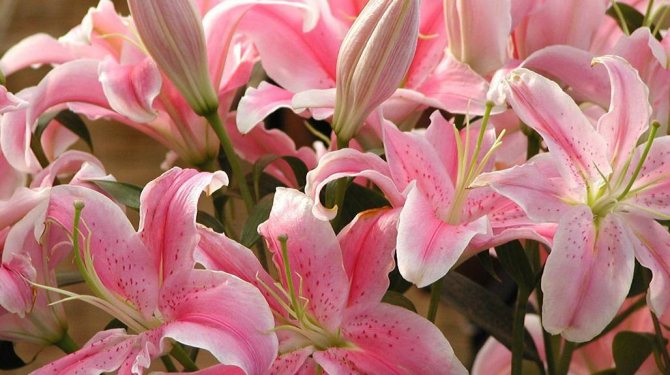

Often, a lily is given and bought already in a blooming state. I don't want such beauty to be short-lived. How to keep blooming and ensure long life of the flower in the room? Let's consider this issue in more detail.
- It is imperative to feed the plant at least once every 24 hours with mineral fertilizers. It is also recommended to spray the flower every day to increase the flowering period.
- When all the flowers have faded, and the foliage, along with the stems, turn yellow, you need to transplant the plant into another permanent pot. The supra-root part cannot be trimmed.
- Reduce soil moisture to once every 7 days. Do not spray the crown, but supplement the soil moistening with mineral fertilizers and organic matter. So all the nutrients will accumulate in the root system. This is important, because flowering buds begin to form for the next season.
- Stop watering 14 days before digging. The babies should be removed as soon as the bulbs are scooped up. Rinse large onions and soak in potassium permanganate for half an hour. Then dry it for a few hours, and then put it in a bag with Sfagnum moss or sawdust. Moisten them. Locate in a basement or other cold room.
The subtleties of growing homemade lilies in a pot and caring for plants
You can get rich and long-lasting flowering only if all agrotechnical requirements are met. Growing lilies in pots is a fun and easy process. It is enough to provide full-fledged proper care of lilies in pots, to carry out regular watering and feeding with a balanced composition of mineral and organic fertilizers. Let's figure out how to care for a potted lily. So, the planting was carried out correctly and successfully, now you need to wait for the sprouts to appear. For this period, a low temperature should be provided and watering should be carried out as the earthen coma dries up. This is about 1 time in 3 days. In principle, a house lily in a pot does not require much care. After the shoots appear, the first feeding is carried out with a solution of organic fertilizers. After 7 days, re-feeding is carried out using a phosphorus-potassium composition. It is advisable at the time of initial growth to spray the sprouts with solutions with the addition of a growth stimulator. This is done about 2 times a week. This technique stimulates the formation of flower buds and ensures the development of large, colorful buds. After the sprouts reach a height of 10 cm, add earth to the upper edge of the pot. Then, caring for a home lily in a pot is reduced to regular loosening of the soil to a depth of 5 cm to ensure the flow of fresh air to the root system. Watering is carried out daily. Top dressing with mineral and organic complexes for flowering plants at least 1 time per week. At the age of 1 month, a lily in a pot can be taken out into the open air. But this must be done with preliminary hardening. Carry out on the first day for 30 minutes, on the second - for 1 hour, on the third for 2 hours. And so the period of stay in the fresh air is gradually brought to 10 hours. Exposure to night temperatures below 10 degrees Celsius should be avoided. This inhibits the process of setting flower buds. Until the buds bloom, caring for a home lily in a pot can be supplemented by daily spraying of the deciduous mass. This allows for faster growth and development. Outdoors, there is one rule to follow. During spraying and until the moisture dries, there should be no direct sunlight on the leaves. Otherwise it will cause sunburn. After blooming flowers, when spraying, you should avoid getting water on the petals. Moisture will shorten the flowering period.
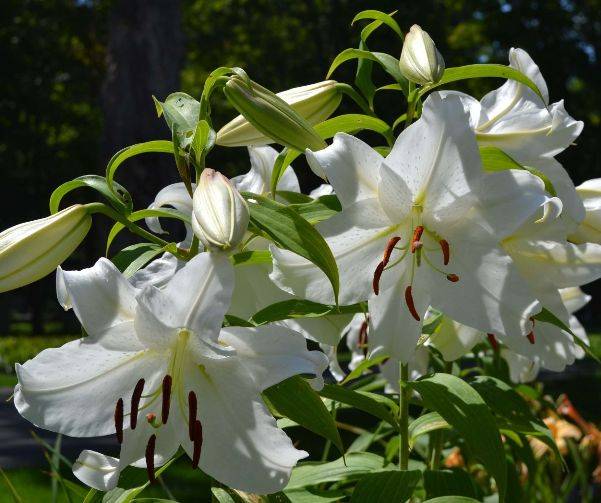

If there are a lot of buds and they are heavy, then it is necessary to install supporting structures that will support the stem. Take a look at a photo of potted lilies that you can successfully grow in your home with the effort and advice given above.
Care features
A house lily in a pot will not require much attention to itself. How to care for a plant? There are a few simple guidelines to consider. You need to water the plant a little, but quite often. In this case, each time you need to check the ground with your finger to avoid excessive moisture in the soil.
The plant loves to be sprayed with a spray bottle. This helps to increase the level of moisture, as well as cleaning the leaves of the plant from dust. Periodically, the soil will need to be loosened. Humus is poured into it. A small amount of peat can be added.


During the flowering period, you need to prop up the stem so that it does not break. Considering how to care for a lily in a pot, it is also worth noting that she loves coolness and free space. In this case, the plant will be healthy and beautiful.
The soil needs to be fertilized. The first time, this should be done immediately after planting the bulb in the ground. Further, during the flowering period, fertilizer must be applied to the substrate. The last time you need to fertilize when the flowering ends. You can add wood ash to the pot. It strengthens the plant by strengthening its immunity. The defenses of the plant in this case will increase.
If the lily grows in a pot, it will not bloom in the first year after planting. You need to wait until the plant is ready to please its owners with bright, spectacular flowering.
When the lilies in the pot have faded, you need to cut off the dried stems.They are taken out of the pot and then placed in the sand. It must be moistened beforehand. Then the container must be taken to the basement. Wet moss can be used instead of sand. If there is no basement, you can leave the shoots on the bottom shelf of the refrigerator.
General description of the plant
Lilies differ in the presence bulbs, which consists of grass roots, arranged according to the principle of shingles. From the bottom of the lily bulb, a simple stem begins, which branches out at the top. The leaves of the plant are mostly sessile, growing in a spiral. Only in two species do they grow on petioles.
A bud is located at the bottom of the plant on the last leaf, a young bulb is formed from it, which after a while separates and, falling to the ground, allows the flower to multiply. The flower-bearing stem of a lily, planted from a seed, appears only after a few years and begins to bloom.
In autumn, fruits appear in the form of boxes, in which there are flat seeds covered with a membranous rind.
For what reasons may a room lily not bloom?
Sometimes it happens that lily does not bud at all... There can be many different explanations for this.
- The plant suffers from an overabundance or lack of light.
- Too large a pot was used for planting, so the flower is aimed at maximizing the development of the available territory.
- Lily does not receive the required amount of nutrients, in this case it is necessary to increase the amount of fertilizers.
- The plant is deficient in the amount of supplied air.
- For the development of the bud, there is not enough moisture (or too much of it, which does not allow the plant to "breathe").
Care
Pruning
The crown formation procedure is optional. But after flowering on the plant remain
withered flowers that must be removed on their own. Together with them, the ovary is cut off.
Seed bolls should not be allowed to appear
Reproduction
seeds used only by breeders. The bolls greatly deplete the plant, after which it will begin to ache. Therefore, at the beginning of autumn, when the leaves begin to fade, the flower growers cut off the branch with the ovary and the seed box. This plant is not suitable for composting. Therefore, it is recommended to burn the stems.
Landing
This representative of the flora does not grow well in calcareous soils. The soil
must be slightly acidic or neutral 5.9-6.7 pH.
Important
so that black soil contains a large amount of vitamins and minerals. You can use purchased soil for home flowering lilies.
You can also prepare the substrate yourself. For this use
leafy soil, turf, humus, peat. For air permeability, crushed charcoal is placed.
Allowed
the addition of coarse sea sand in very small quantities. Drainage from pebbles, clay shards or natural stones is laid at the bottom of the pot. You can use granite, rubble, gravel or crushed stone.
The use of stones containing limestone is prohibited.
The containers should be 2-3 cm larger than the root system of the plant. Planting depth depends on the size.
Care and feeding
If you follow the recommendations for caring for a white lily, it will bloom very beautifully, fill the house with a magical aroma. There are several general rules that should be used when caring for different varieties of an ornamental plant:
- Watering. All species need regular but moderate watering. Waterlogging of the soil should not be allowed, this can destroy the white lily. Lack of moisture also negatively affects the condition of the flower.
- Top dressing. Throughout the growing season, the plant must be fed with organic fertilizers. A non-concentrated, liquid mullein solution, similar in consistency to regular water, is best suited for this.
- Airing. All species are sensitive to dry and stale air. The room in which the plant is located should be regularly ventilated, but drafts should not be allowed.
- Lighting.Indoor lily is a light-loving plant that requires care and maintenance. For normal growth and development, it needs a sufficient supply of solar heat and light.
With proper care, the flower will delight with bright inflorescences
After flowering, all species enter a dormant period. At this time, leaving will be slightly different. The flower needs to be moved to partial shade, watered less often, no need to feed. After the end of this period, mineral fertilizers are applied to the soil. Why is this necessary? To provide the plant with strength for abundant and long-lasting flowering, saturate with useful substances.
How to provide lilies with a dormant period during the winter season
Indoor lilies slow down development in the autumn, the leaves turn yellow, the plant stops growing. During the rest period, the flower is kept at + 5 ° C in a shaded space, the sun's rays are unacceptable. It is required to reduce watering, the soil is moistened when the soil dries. By the spring period, the pot is placed on the windowsill and the regularity of soil moisture is increased.
Bulky bulbs, after inspection for rot and deformation, must be placed in a dissolved potassium permanganate for 0.5 hours, then put on a cotton cloth and dried.
After pruning, damaged bulbs must be disinfected and treated with ash or charcoal.
The prepared material is placed in a place with a temperature of about + 5 ° C.
Planting indoor varieties
Planting lily bulbs (tubers) in a pot
Before planting a room (room) line, you must select a pot, soil and provide adequate drainage. Planting and growing indoor lilies at home will not take much time and hassle.
The pot should not be more than 20 cm in diameter.
Pour drainage on the bottom (about 3 cm). For soil, use a soil mixture designed for plants with bulbs or nutrient-rich, organic soil.
Plant the bulb to a depth of about 8 cm, stepping back 3 cm from the edge of the pot.
There is one onion per pot. The pot should be half full.
Transplant rules
After 3 years, new shoots can be transplanted. A similar procedure should be carried out every 3 years. Before you dig up the plant, you need to cut the flowers. This is done so that the lily bulb does not weaken. Dig up new bulbs as carefully as possible in a small pot.
Diseases of indoor plants and their treatment
Diseases of a room lily, as a rule, occur due to a large amount of moisture, a low supply of oxygen to the soil, or when infected with harmful organisms.
- The bulb rots and grows moldy
, it is necessary to limit watering and change the soil. Potential causes include insufficient drainage or heavy soil. - If the flower turns yellow, becomes dry, has lost color,
it is necessary to increase watering frequency. - The presence of insects such as flies, aphids, or beetles.
In this case, use special means aimed at eliminating dangerous insects.
Prevention of the occurrence of such diseases includes strict control over the frequency of watering and the air permeability of the soil.
Helpful advice from experienced gardeners
Novice growers need to consider some more nuances of growing lilies:
- If the regions are characterized by severe frosts, it is preferable to dig up the bulbs, transplant them into a box filled with earth, which is recommended to be stored in a cool place until spring.
- It is advisable not to put the bulbs in plastic bags for storage. It is best to keep them in thick paper, cardboard box, cloth. Moisten slightly occasionally.
- To prevent fungal diseases, you can immerse the onions in a saturated raspberry solution of manganese or Maxim for half an hour before planting.
- To prevent cross-pollination, it is preferable to plant lilies of different varieties at a certain distance from each other.
- Lilies, which are light, white in color, grow well in lighted places, sheltered from the winds. Flowers painted in dark tones can be grown in partial shade.
- In case of defeat by fusarium, bacterial (wet) rot, HOM preparations, phytosporin, abiga-peak, Bordeaux liquid are used.
- Lily fly, aphid, orange-red beetle are afraid of karbofos, sparks, inta-vira, phytoverma, actara, actelika.
- Bears, thrips, wireworms, May beetles will disappear from lilies after spraying with provotox, medvetox, thunder, fly eater, earth, and initiative.
Taking care of a lily is not that difficult. You just need to strictly follow all the recommendations described above.
How to plant a leopard lily


Planting leopard lilies in the ground is recommended not earlier than May, when the possibility of night frosts will be completely excluded. When distributing plants on the site, it is best to maintain an interval of 15 to 20 cm between planting holes.
In order for leopard lilies to quickly adapt to a new place, it is advisable to prepare the soil by applying fertilizers. For these purposes, organic matter is suitable - both humus and traditional compost.
Possible difficulties in growing
- The plant turned yellow, became dry and changed color - the number of watering should be increased.
- The presence of aphids or bugs on a flower - it is necessary to use special means to eliminate them.
- The bulb becomes moldy or rotting - change the soil, reduce the frequency of watering, and pay attention to the severity of the soil and drainage.
As for the flower itself, it is the personification of refinement, purity and, depending on the type and color, can convey different meanings, not to mention its healing properties.
It will be interesting for you to watch a video about planting a lily in a pot:
Chinese lily: gardening use


This daring and invariably eye-catching exotic perennial always finds its place in the center of the composition. In the decorative design of a garden plot, it can be used in different ways:
- with the help of bright leopard lilies, spectacular spots of color are created on lawns and lawns;
- rather high stems of these plants make them convenient for the formation of mixborders;
- the obvious role of a catchy flower is an attention-grabbing accent in the composition of the flower garden;
- the neighborhood of a leopard lily with ornamental shrubs and trees makes the forest edges spectacular;
- compositions of fiery shades cannot do without leopard lilies;
- in pot compositions, these plants also successfully cope with the role of accents.
Why did the lily turn yellow
Lily demands attention. The indoor lily has turned yellow, a photo of the flowers can be seen below. Novice flower growers are interested in what can be done, how to save the plant? It is necessary to understand why this happened.
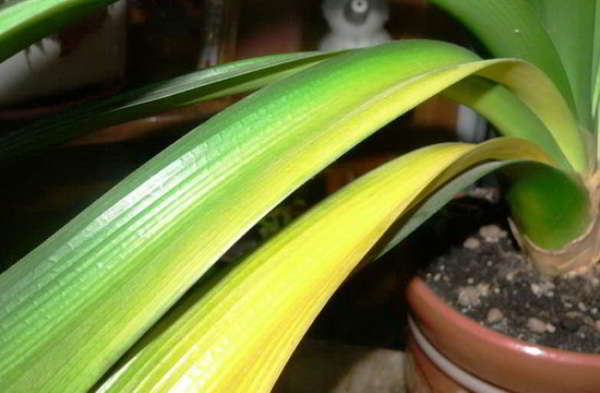

Causes of yellowing of leaves, stems:
- Autumn has come;
- watered incorrectly;
- the ambient air is too dry;
- insufficient nutrition.
If the lily turns yellow in the fall, then this is normal. In case of mistakes in care, it is required to humidify the air, water it in the morning and in the evening, feed with those fertilizers that contain potassium and iron.
Choosing a container for a lily
Before planting a lily, it is important to choose the right pot for it.
First of all, you need to choose the right container for the flower. This is especially true of bulbous varieties. They can reach up to 1.5 m in height. And the higher the adult plant is, the deeper the pot should be selected for it in advance. How often the lily blooms will depend on this.
If it is assumed that the height of the plant will be about 1.5 m, then a pot with a depth of about 40 cm is needed. So the roots will be spacious enough in it, the lily itself will be stably fixed in the ground, which is very important in the first time after transplanting.
You also need to correctly determine the width of the pot.So, if you plan to grow one plant in one container, it is recommended to use a fairly narrow pot (about 20 cm in diameter). Otherwise, the plant will constantly release babies, thereby trying to fill the free space in the ground.
You can also make a very interesting arrangement of bulbous lilies by planting 3-4 plants in one pot. At the same time, it is important to keep a distance of about 5-7 cm between them. So the land will not be free for the growth of children, and in the end such a "bouquet" will look quite beautiful. Indeed, during the flowering period, lilies release several buds at once.
Back to the table of contents
Soil and fertilizers
In garden stores, ready-made potting mix for bulbous plants is sold. Lilies love loose, sandy soil with neutral acidity. In heavy and moisture-consuming soil, the bulbs can rot. You can prepare the soil for planting yourself. 2 parts of ordinary land will require 1 part of coarse river sand. Before planting, the finished mixture must be disinfected. For example, spill with boiling water or a solution of potassium permanganate.
For lilies, home care requires additional nutrients in the same amount: nitrogen, potassium, phosphorus and magnesium. They are needed for the growth and development of the plant. For this, 50 g of complex fertilizer is applied to 1 liter of soil.
Indoor or house lily. care and cultivation. Practical advice
For growing at home, varieties of lilies are used, suitable for development in pots, boxes, on racks. The plant stretches up to 0.4-1.5 m. The stems are dense, dark green in color, the leaves are large, elongated. The shades of the buds range from monochrome to bright, combining several contrasting colors.
During the flowering period of the lily, an illuminated space is needed.
Regular spraying of the bush is required. In winter, the temperature for the plant can be maintained at + 16 ° C.
Types and varieties of room lilies
The house lily is grown by breeders in over 300 varieties. Varieties for planting in greenhouses and houses differ in the configuration of the buds, stem height, and care requirements.
Flower varieties are divided into subgroups:
- cupped;
- funnel-shaped;
- fezoid;
- hybrid.
Cup-shaped lilies have buds with wide-open petals. Subspecies include the names of the varieties Grand Commander, Gilded Lily, Empress of China, etc.
Funnel-shaped cultivars have buds with petals rolled into a tube. The variety combines the Regal lily, Royal Gold, as well as hybrid species with bud color in lemon, pink, milky shades.
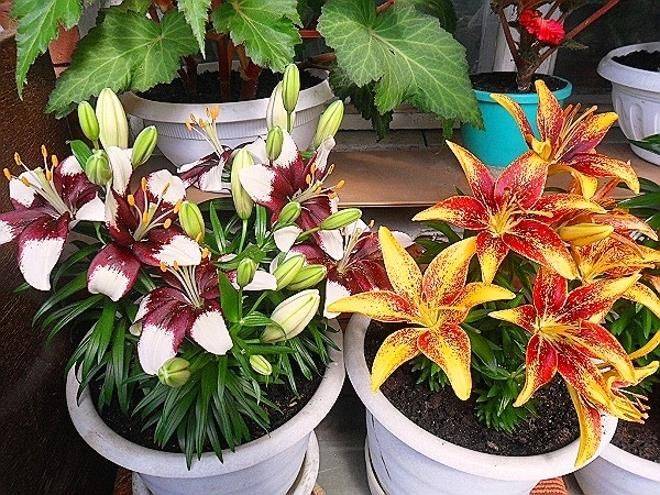

Hybrid varieties are designed for growing at home. Asian, Taiwanese, Oriental hybrids are in demand. Asian lilies are distinguished by voluminous buds, curved petals covered with specks, thin stripes, the variety has no aroma. Taiwan lilies of small height (40 cm) with large buds of bright color. La hybrids are also widespread.
Variety selection
Classic lilies are intended for cultivation in flower beds, front gardens. For home cultivation, hybrid varieties of lilies Lovely, Golden, Royal are recommended. In greenhouses, a white lily is also bred, exuding a rich aroma, the plant reaches a height of 15 cm.
Tubular and goblet flowers with white petals interspersed with red, golden, brown colors are suitable for cultivation in rooms. At home, you can also breed terry varieties. Optimal cultivation on the windowsill of unpretentious tiger varieties that differ in their original color.
How to determine the type of lilies on the bulb
Different varieties of lilies require the implementation of recommendations for care, soil selection, level of illumination and watering. The type of lily can be identified by the appearance of the bulb.
White bulbs are of Asiatic lilies, LA hybrid varieties.Varieties need slightly acidic soil, fertilized with ash.
Oriental plants have bulbs with a loose texture, combining several shades (pale pink, golden, purple). Sorts pick up oxidized soil, the introduction of ash is prohibited.
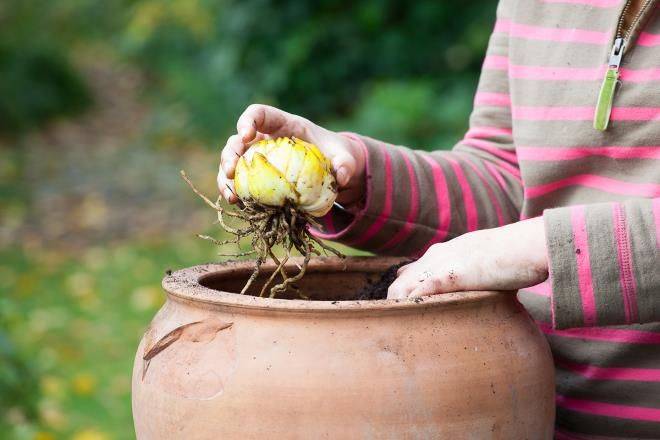

Bulbs of tubular varieties, which develop on soil with the addition of lime, have a purple hue.
Pinkish, golden bulbs in hybrid varieties (dwarf lily, beautiful lily), intended for growing on a balcony or street.
Bulbs of the same variety are placed in a tub. For a one-time flowering of bushes, the bulbs must match in size.
Varieties and types
The flowers are quite large, have 6 petals, slightly resembling a lily, which is why there are a number of names that exist among gardeners: chinese lily
,
chinese orchid
... Flowers live very shortly, only one day, after which they wither, but the next morning new buds open, which ensures long flowering.
The color of the petals can be different - from yellow to pink, a characteristic feature of these flowers are dark spots on the petals. The fruit resembles a blackberry, but is inedible.
Also, this plant has varieties obtained as a result of hybridization:
- has enlarged yellow flowers without dark spots.
Belamcanda cultivar purpurea
- the color of the petals of this variety can be from pink to purple tones.
Or fan
- decorative and deciduous variety with inconspicuous small flowers.
Planting seeds
The size of the lily seeds is 0.5 x 1 cm. The seeds are left in the refrigerator. Then they are scattered over the sand. The gaps between them should be 1 cm. After that, a small layer of sand is applied. Carefully water and cover the seed containers with foil. Seeds must not be poured. The germination temperature is maintained at 20-22 ° C. The sprouts appear in about three weeks.
Pots with small plants are taken out to a lighted place. Their daylight hours should be 12 hours. Small lilies are protected from direct sunlight. When two leaves appear, they are seated in separate pots.
What affects large-flowered eucharis


Parasites can settle on eucharis.
The Amazon lily differs from other members of the family in its unpretentiousness. The plant forms buds easily every year. With proper care, you can get an abundantly blooming crop.
To create a spectacular bush, you can plant several bulbs in a large container. Regular feeding stimulates the formation of numerous leaves. Eucharis is not recommended to be planted in a group with other plants. Room lilies need to create sufficient space.
Despite the significant advantages, complete non-observance of the rules of care can cause damage to the plant by diseases and the appearance of pests.
The main danger among insects for eucharis is scale insects. The appearance of brown plaques on the leaf blades and stems indicates the defeat of the flower.
Parasites in a matter of days of "inactivity" can suck the juices from the tissues of the lily. How to save eucharis? The plant should be inspected regularly. At the first signs of loss of leaf gloss, revealing drying and fallen areas, pests should be collected. You can also catch insects using special traps.
The cleaned plant must be treated with soapy water. It is advisable to wipe the leaves with a damp sponge dipped in soapy water. All areas should be sprayed with Actellika solution. You will need a 0.15% drug. For one procedure, it is recommended to use two milliliters of the product and one liter of settled water.
Dry air, combined with high ambient temperatures, promotes thrips to settle on lilies. Insect colonies primarily settle in the lower areas of the leaves. The characteristic light markings can be seen on the top of the plate.
Insecticides will be required to kill pests.Decis, Fitoverm, Intavir and Aktellik have an effective effect on parasites.
How to prevent diseases and pests
If the conditions of keeping the plant are normal for its life and development, it will not be necessary to get rid of diseases - they will not appear. Well, if something was not taken into account during the care of the lily, then here is an analysis of the most popular problems that the owners of the room lily have.
Probably the most popular one is the appearance of red rot on the bulb... Most often it occurs due to cold and humidity. You can get rid of it by cutting off the affected areas and treating with activated carbon. It is important then to reduce the intensity of watering.
The most common parasites on indoor flowers are spider mite and scale insectthat can not only harm the plant, but also destroy it. They have to fight with special insecticides, which are sold in gardening stores.
Choice of place and conditions of detention


Successful cultivation and splendor of flowering will depend on the correct choice of a place for a pot with a lily and on the conditions created around it:
- Illumination... Lilies need good lighting. But her delicate petals are harmed by too bright sunlight, so in the summer she needs to create shading, and in the winter it must be illuminated with phytolamps. Pots with blooming lilies are best placed at home on the sills of windows facing south and west.
- Temperature. Lily prefers to bask in the warmth; in winter she needs a warm windowsill. After planting is completed, the pot is kept for 2-3 months in a dark room and at a stable air temperature of +5 degrees. For this purpose, a cellar, a cold basement or an unheated garage are suitable. After a couple of months, the pots are moved to a place with an air temperature of +10 degrees and left there until seedlings 5 cm high appear.Further, the ambient temperature must be increased to +18 degrees, while at night the coolness should remain up to +10 degrees. When the buds that appear are colored, the pots can be rearranged on a suitable windowsill.
- Air and humidity. Potted lilies are afraid of drafts, but airing the room will not interfere with them. Before the appearance of lily flowers, it is necessary to spray a couple of times a month, they are quite moisture-loving plants. After the appearance of buds, lilies continue to spray, at this moment it is necessary to remove the plant away from the sun's rays until the moisture on it dries out. To increase the humidity of the air near the lilies, it is advised to place vases of water or an aquarium with fish. It is allowed to place a pallet with wet stones under the pot.
- Soil and pot. Lilies will thrive in fertilized, loose soil. Usually they buy ready-made soil mixture for lilies. But you can compose it yourself by mixing garden soil with compost, sand and humus in equal proportions. It is preferable to choose a pot of clay or ceramic. Its diameter depends on the number of bulbs planted. A pot of 16-18 cm in diameter will be appropriate for a single bulb, for three bulbs you need to choose a pot with a diameter of 40 cm.The height of a lily pot is usually about 40 cm.It should be taken into account that the bulbs should not be planted in an unnecessarily spacious pot. Instead of releasing flowers, they will take up free space with separating babies.
Flowering plant and description of problems
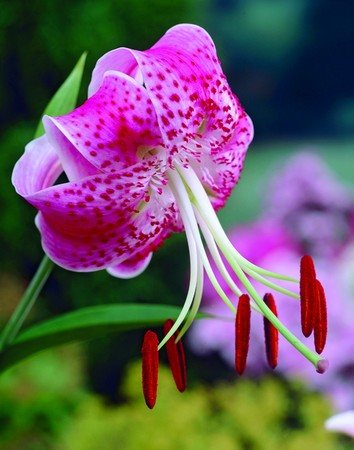

Only on our website 56 varieties of lilies are described
Lilies, as a rule, do not bloom in the 1st year of life.
From the second to the fourth, the peak flowering is reached. Plants bloom magnificently and luxuriously. At the end of the fourth year, flowering weakens, then completely stops. Just at this time, the plant sheds offspring.
If the lily is not blooming, then most likely you have the hippeastrum variety.It requires special care: from the beginning of spring to October, provide the plant with sun, watering and frequent feeding (once a week). Limit watering and sun from October.
Watering
Lilies are very fond of moisture, and with insufficient supply of it, the long-awaited flowering period of plants may never come. It is very important not to allow water to stagnate in the soil for a long time, and this requires good drainage. Watering should be carried out with settled water at room temperature. A slightly dried topsoil will indicate the need for moisture. If the temperature in the room where the plant is kept is high enough, then the lily can sometimes be sprayed, while avoiding moisture on the flowers.
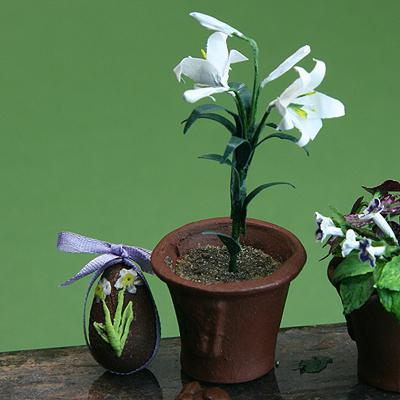

Detailed description of home lily
It is a perennial plant that propagates by bulbs. The bulbs can be both small and large, with a diameter of up to 5-6 cm. The shape of the flowers can be cup-shaped, star-shaped, bell-shaped, funnel-shaped, tubular, etc., but the color palette is varied. Immediately after flowering and falling of the petals, a seed capsule is formed in place of the bud. If you do not touch it, then the seeds will ripen and sow, thus reproduction will occur, as in natural conditions.


The indoor lily flower is a compact small plant, as in the photo. The bulb will fit easily into a medium-sized pot. Domestic lily is classified by species and varieties.
- Dwarf - grows up to 50 centimeters, flowers have a diameter of 3-5 cm.Buds of a unique shape, petals are bent.
- Cup-shaped - the buds open wide.
- Funnel-shaped - the petals at the very base are collected in a tube.
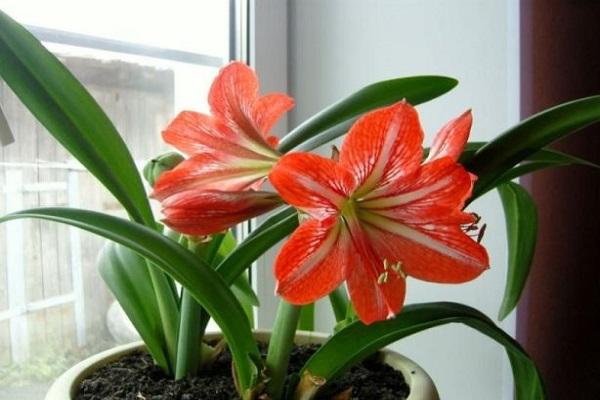

A variety of shades will delight lovers of unusual colors, because room lily petals come with yellow, red, brown spots or stripes. On each peduncle, 5-6 buds can bloom at the same time. In indoor conditions, compact varieties of flowers grow well. It is better to give preference to dwarf, Asian, oriental lilies.
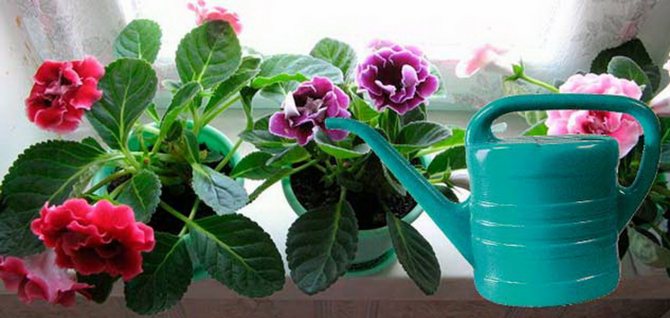

Care during growth and flowering
Indoor lily, when caring at home, requires certain conditions during the growing season and flowering. When the bulbs germinate, organic feeding is carried out. A week later, phosphorus-potassium fertilizers are applied. Additionally sprayed with growth stimulants 2 times a week. When the lilies grow to 10 cm in height, soil is poured into the container. Complex mineral-organic fertilizers continue to be applied weekly. In the warm season, young plants can be taken outside. For this, the lilies are hardened, gradually increasing the duration of their stay in the fresh air from half an hour to 10 hours. If the temperature stays below 10 ° C at night, the flower buds will not develop well.
General rules of care:
- In the process of growth, lilies are tied up or substituted for them, since their flowers are large and heavy.
- Water the plant often, avoiding excessive moisture. You can check the ground with your hand.
- Lilies love to be sprayed. It is impossible for the buds to get water, otherwise the flowering period will be shortened.
- The soil should be loosened by adding humus to it.
- It is necessary to weed the soil from weeds.
Various varieties of indoor flowers of lilies have their own characteristics in care:
- Asian hybrids are considered the most unassuming. These plants have a long stem. Petals are monochromatic or painted in two or three colors, often interspersed. They love the sun and partial shade. When growing them, you need moderate soil moisture. They have a fairly stable immunity. These flowers are odorless, so many people prefer to keep them at home. Includes five thousand varieties.
- Lilies Martagon (curly) - tall plants with turban-shaped drooping flowers. They grow on almost any soil, shade-tolerant. Frost resistant. They have good immunity. In total, about 200 varieties are classified as curly lilies.
- Snow white hybrids include plants with white and cream flowers. They require a lot of attention and knowledge in care. They smell good. Poorly tolerate cold. Susceptible to disease. This group is made up of about 30 varieties.
- Long-flowered lilies have large, elongated flowers. They have a strong aroma. Not hardy. Popular as indoor plants. Currently, low varieties have been bred, reaching 40 cm. They are susceptible to pests.
- Oriental hybrids can be purchased in blooming stores in stores. They have large flowers. They love warmth and sun, loose and light soil. The group includes 1300 varieties.
The nuances of growing at home
In order for the lily to bloom and delight the eye, it needs good care. In turn, this depends on many small points.
Choice of place and conditions of detention
It is recommended to keep the flower in a dark place until green shoots form. In this case, the air temperature should not be high. If the green mass appears above the ground, the pot is taken out to the windowsill or other suitable place. In summer, they provide access to fresh air masses.
Preparation of planting material
Light fertile soil mixed with sand is the best soil for a plant. Before placing the onion in the ground, it is hardened in the cold. A refrigerator door works well for this. If necessary, the material is soaked in potassium permanganate and dried.
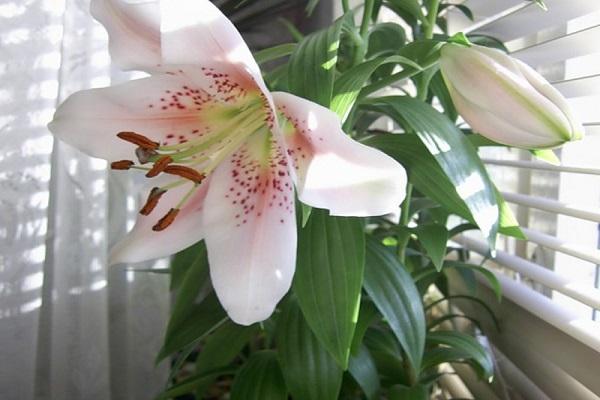

Planting instructions
The bottom of the container is covered with drainage, covering it with a nutritious soil mixture. After installing the bulbs, the roots are straightened and covered with the same prepared soil from above. Half fill the pot, while part of the onion should be visible. As soon as the domestic lilies rise above the container, the soil is filled up.
See also
Is it necessary to dig lilies for the winter, preparing a shelter, when to cut and how to storeRead
General information
This species is not the only one of a kind, but only it is grown in culture. It is interesting that, although the plant is cultivated, it is quite rare in the wild and is listed in the Red Book.
This perennial plant has a wide rhizome lying close to the soil surface. It is a medium-sized species with hard foliage that can reach half a meter in length and about 30 cm in width.
Peduncles are also long - up to 1 m, or even higher. At the top of the flower shoot, up to 20 buds are formed, which open several pieces at a time.
Planting capacity
The planting capacity is selected taking into account the size of the plant that will grow in it. The pots should be deep enough as indoor lilies need room to grow their roots. In addition, about 5 cm is left from the edge to the surface of the soil. Such an indent is needed for further filling of the earth, since additional roots are formed during the growth of lilies. The preferred container height is 30-45 cm.If one bulb is planted with a circumference of 10-12 cm, then the diameter of the container should be 20-23 cm.When three or four bulbs are planted together, the diameter of the pot is 23-25 cm.The distance between future flowers should be 5 cm. Drainage holes are required in the container.
Features of watering for a flower
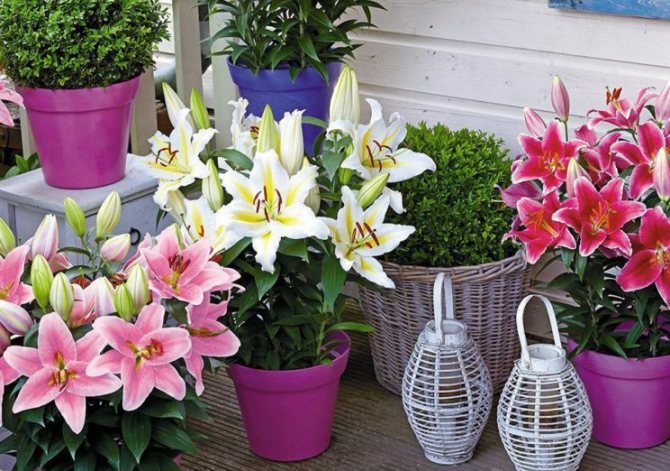

Flower lily photo indoor
Indoor lilies in the spring and summer usually need to be watered more often, but with less water. And since bulbous flowers rot the fastest, it is imperative to ensure that there is no increased dampness.
The best option would be to water the flower a little in the morning in the early hours, and also if the upper part of the soil begins to dry out, then the same procedure should be repeated, but in the late afternoon. Do not forget also the fact that the plant should be watered with exceptionally soft water at room temperature.
Diseases
Indoor lily can be susceptible to various diseases. Moreover, both viral and fungal.The causes of the onset of diseases include improper care of the plant and the acquired planting material already infected.


Experienced florists identify among the most common diseases:
- botrytis - gray rot;
- fusarium - soft rot;
- mosaic.
Most often, the lily is affected by gray rot. This is a fungal disease that occurs due to high humidity, since excessive watering creates favorable conditions for the development of the fungus.
You can identify the fungus by the small yellow spots that appear on the lower part of the leaf. With the development of the disease, the area of the lesion begins to increase, and the spots already become gray, and the areas themselves become fluffy. Gray rot begins to affect the stem and reaches the bulbs, as a result, the lower part of the flower disappears.


If the lily has undergone such a fungal disease, then all affected areas of the plant must be cut off and destroyed. And remove the bulb itself from the pot, rinse, hold for half an hour in a 0.5% Fundazol solution, and then plant it in a pot with new soil.
It is easy to grow an indoor lily at home, and even novice flower growers can have such a beautiful flower as in the photo in their home. A couple more tips. In the first year of flower growth, the lily needs to be cut off the ovaries. During the period of bud formation, it is necessary to intensify the irrigation of the flower. And if the plant is affected by a disease, then it is important to remove all the buds, even healthy ones.
Landing rules
For planting lilies, a large pot of sufficient depth is required. The flower needs soil preparation, drainage. It is important to leave 3-4 cm of the height of the container empty. When the stems appear, it is required to add soil to the container.
After planting, the pot is placed in a place with cool air (a suitable temperature is no more than + 10 ° C). The flower needs regular watering. However, water should not be trapped in the ground, so the sump must be emptied of excess liquid.
When pulling the stems up to 10 cm, it is required to move the plant to a place with air heated to + 16 ° C. The room temperature can rise as the flower develops. From planting to flowering lilies take about 18-20 weeks.
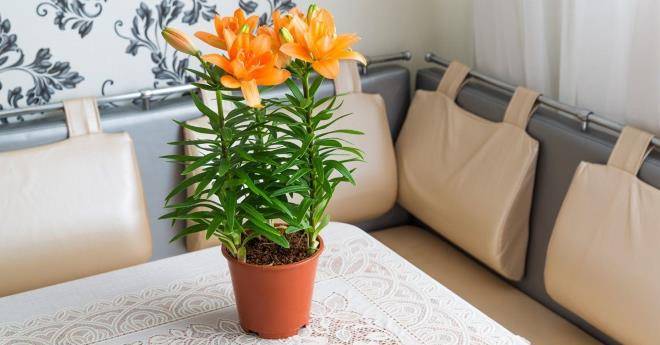

Preparing garden bulbs
It is necessary to dig up the bulbs in the fall (end of September - first half of October). Then the material is laid out in wooden boxes, the bottom of which is lined with sphagnum or peat. Storage is performed at temperatures above + 10 ° С. Moisturize the soil within 2 months. It is important to prevent stagnant water and to clean the sump regularly.
The composition of the soil for growing lilies
Potted lily is grown in specially prepared soil. The soil needs light, loose, filled with nutrients.
The soil contains the following ingredients (in proportions 3: 1: 1: 1):
- turf;
- leafy soil;
- humus;
- cleaned river sand.
To plant Liliaceae, you need to create a drainage layer. Optimal use of expanded clay, ceramics, sawdust, pebbles. At least 1/3 of the capacity is allocated to the drainage layer. It is not recommended to use bulky pots, because flowering period can be reduced. Drainage is laid in layers. In a greenhouse, you can plant bulbous varieties in a tub, decorative box or container.
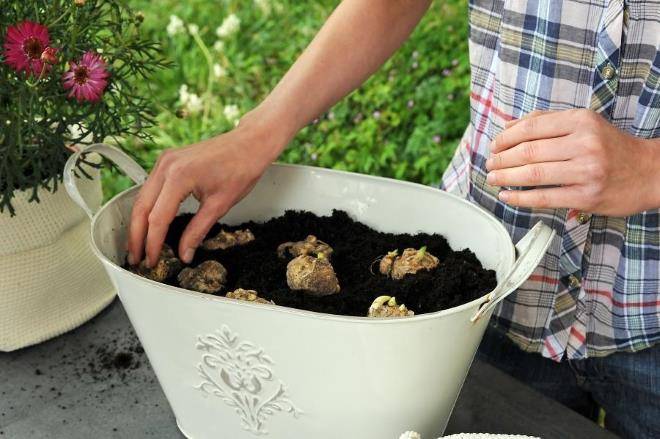

Flower planting rules
To plant a room lily at home, you need to buy the bulbs of an ornamental plant, and be sure to ask what kind it is. Healthy planting material should not have brown scales, be shriveled. You will also need a spacious pot with a diameter of about 20 cm. Planting consists of several stages:
- First, you need to disinfect the planting material. The bulb is placed in a 1% manganese solution for half an hour, then taken out, left on a paper towel until completely dry.
- During this time, we put a layer of drainage on the bottom of the pot. It can be expanded clay, crushed stone, broken brick.
- The soil mixture is laid out on the drainage layer.It is best to use a special lily primer that you can buy at a flower shop. If not, take the soil pre-fertilized with compost, mix it with sand and use it for planting a lily.
- We place the roots in a pot, cover with earth so that it covers half of the onion, lightly ram it.
- We place the flower pot on the windowsill so that enough sunlight gets on it.
When sprouts appear, the indoor lily is placed in a permanent "residence". It should be sunny and well ventilated.
Fertilizer
Indoor lily needs additional feeding, and fertilization is necessary from the period of stem formation. It is recommended to use a special fertilizer intended for flowering plants, or alternately apply mineral and organic fertilizing and do this first three times a month until the buds appear. Further, feeding should be done less often - no more than once a month.
So, for example, these indoor flowers will respond perfectly to nitrogen and potassium-phosphorus fertilizers. Periodic adding wood ash to the potted flower will help to improve the growth of the plant.
Belamcanda seeds
Belamcanda easily forms seeds.
They look like small black shiny balls, they hold for a long time on a long-dried peduncle (and the peduncle, by the way, is about a meter high) and go right on it under the snow. But I never observed self-seeding, and I could not germinate the collected seeds even once, although I tried both spring plantings and sowed under the snow. It looks like the seeds need more heat to ripen.
The main disadvantage of belamcanda as a garden plant is, in addition to problems with seeds, a short lifespan - about 5 years. This means that at the age of 4 years, the rhizome should be dug up, divided, as is done with all irises, and planted again. In light of the above, it is understandable why this plant is very rare.
And despite this, I can safely say that belamkanda will be a very good material, first of all for novice florists.
Reasons why lilies do not bloom
Indoor flowers like the indoor lily have a number of factors that prevent them from budding:
- Lack or excess of lighting. Depending on the variety, plants require different amounts of light.
- Large capacity. The plant needs time to develop an earthen coma. Until the root system fills the container, the flower will not start to grow and bloom well.
- Lack of nutrients, especially potassium and magnesium.
- Lilies love spacious rooms with fresh air.
- Improper watering. Lack or excess of moisture.
- Lack of a dormant period.
Variety of colors and colors
Golden, white, dwarf, purple, red - flowers of different types and colors are striking in their beauty and originality, there are more than three hundred of them. Domestic lilies are also hippeastrum and amaryllis, so similar to real lilies. They serve as a magnificent decoration for the window sill, winter garden, balcony and loggia, delighting their owner for a long time with flowering. Some species do not tolerate cold, there are those that are not afraid of frost, therefore, caring for a flower depends on which species it belongs to.
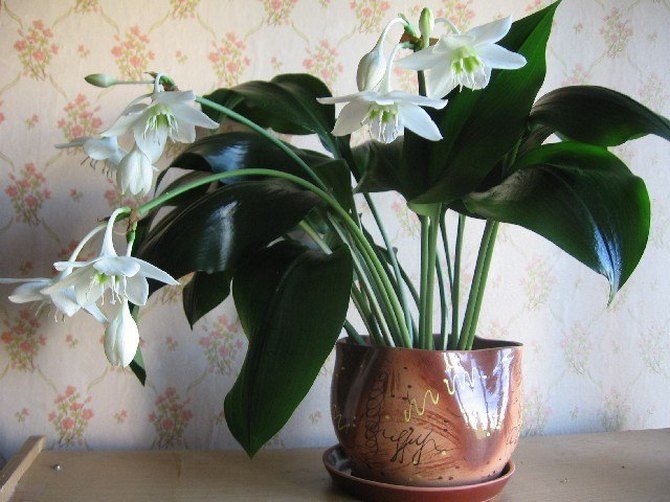

The Apollo lily (white lily) is especially beautiful, the diameter of its flowers, reminiscent of snow-white bells - up to 12 centimeters, they are combined into lush brushes. The white lily is interesting because, in addition to its beauty, which symbolizes purity and purity, it also has healing properties. White lily is used for the preparation of tinctures with analgesic effect, medicines for the treatment of hematomas, cosmetic and wound healing preparations.
Almost all types of plants grow well in indoor conditions.
How to plant lilies
In order for the indoor lily to bloom, you need to know how to plant the bulbs correctly at home.
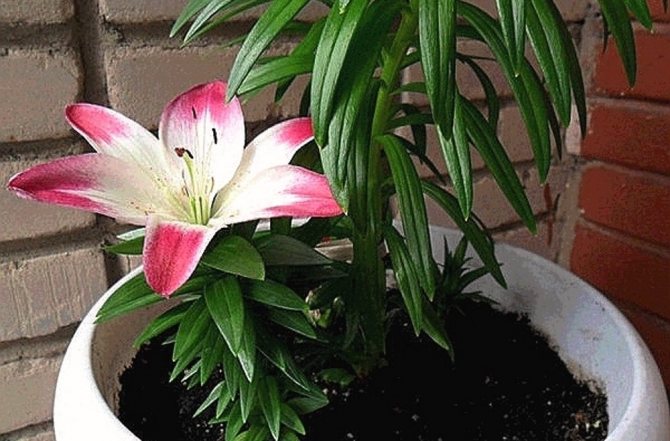

Therefore, before planting a flower, you should carefully study the entire algorithm of actions with detailed instructions and a photo.
- We fill the bottom of the pot with drainage, you can use small stones, for example, expanded clay.
- Pour the earth on top of the drainage, to a height of 5 cm. At home, you can prepare the soil for a flower yourself. To do this, you need to mix 1 part of leafy land, humus and river sand, as well as 3 parts of sod land.
- We make a small depression in the center of the ground layer and place the onion in it, do everything carefully, straighten the root part.
- Sprinkle with soil, slightly compact, the bulb should be in the soil in the middle of the height of the pot.
- Moisten the soil with the bulb with a little water.
- We take the pot to a cool and well-lit place.
- As soon as the first sprouts appear, we transfer the pot with the plant to a permanent place.
- When the first buds appear, we tie the flower to the support.
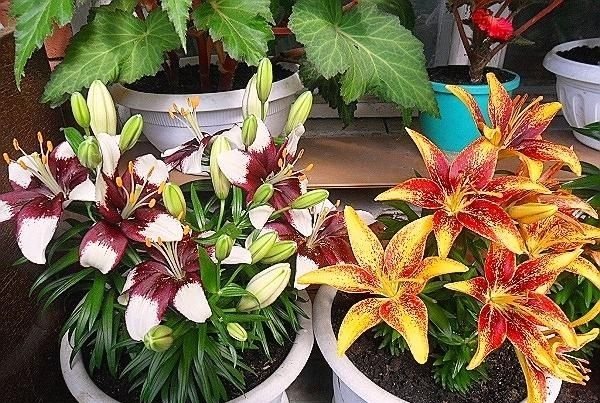

Pineapple lily: cultivation and photos
The pineapple lily variety is grown mainly in the open field, since in indoor conditions the plant blooms only at a good ambient temperature and sufficient lighting, which can be difficult to organize. Therefore, it is left in flower pots only for wintering, and in the spring it is transplanted into open ground (Figure 6).
Note: As a rule, eukomis is grown from bulbs - babies, which are separated from the mother's bulb. The bulbs are planted in separate containers using light, fertile soil with sufficient drainage from early March to late April. In this case, they should be placed so that the top remains level with the ground.
While waiting for the sprouts, sparing watering is carried out as needed, and after the appearance of peduncles, irrigation is made more frequent and more abundant. Before transplanting eukomis into open ground, it is recommended to harden by taking pots with young plants to the open air.


Figure 6. External features of pineapple lilies
It is possible to transfer a plant from a pot to a flower bed only when the soil warms up enough, that is, approximately in mid-May. In the southern regions of our country, eukomis bulbs can be immediately planted in open ground without prior germination. It is important to know that the pineapple lily is a prominent representative of light and heat-loving plants. Therefore, for planting, set aside an area that is well lit by the sun. This variety is completely frost-resistant, so its bulbs must be dug up every year and stored.
The planted eukomis must be watered sparingly until the first leaves appear. Then watering is gradually increased, given that the plant needs a lot of moisture during the flowering period. After the plants have faded, the introduction of moisture begins to decrease, and after the leaves turn yellow, they stop altogether. It is also necessary to regularly feed with complex fertilizers that do not contain nitrogen, since this element causes plant diseases. Unlike other varieties, eukomis under indoor growing conditions requires an annual transplant into a new container with a complete replacement of the substrate. Bulbs from open ground are dug up, disinfected and sent to storage in a dry, cool room.
Top dressing
For the normal development and flowering of a room lily, additional nutrition is needed, with a lack of it, the buds may not form. It must be remembered that nitrogen fertilizers are required for active growth, and potash and phosphorus fertilizers should be applied for flowering.
The plant responds well to organic fertilizing, therefore, starting from spring, you can apply slurry, which is diluted with water in a ratio of 1 to 10. Such fertilization should be done once every three months.
It is best to feed the plant according to the following scheme:
- the first feeding is done at the beginning of growth;
- the second during the formation of buds;
- the third is applied after flowering.
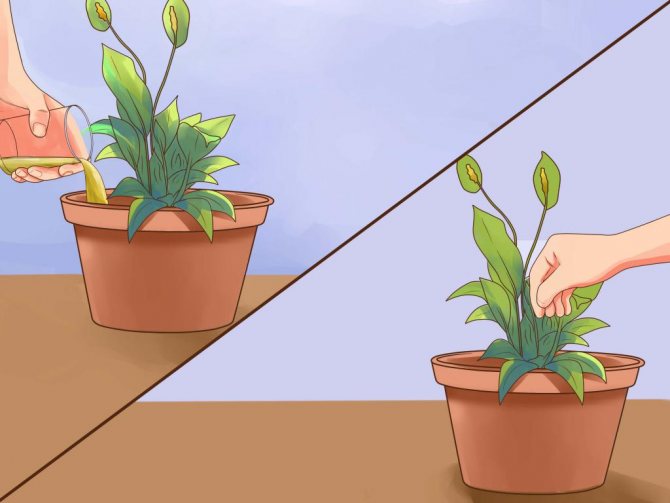

In addition, wood ash can be added to the soil throughout the season. The decoration of any room will be a room lily, photos of the best specimens can often be found in the reviews of florists.


